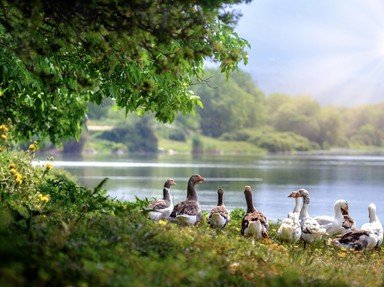Quiz Answer Key and Fun Facts
1. A sure sign of spring hereabouts in southern Ontario is the appearance of this red-breasted feathered friend. How is this chap related to the English (European) robin?
2. This brightly feathered friend flew into my back yard one winter day and posed for me. How does the female cardinal differ in appearance from the male?
3. Moments after this photo was taken, this chap gave me a look that said "Do you have food for me?" Formally called Larus delawarensis, what is his more common name?
4. This very familiar feathered friend is Branta canadensis, the Canada goose, who can be found all over North America, and even beyond. Though they don't always migrate as far south as they once did, noisy formations of this bird can be seen in flight over southern Ontario especially in spring and autumn. What shape does their formation most often take?
5. It's pretty certain that the food in this small feeder wasn't meant for these two big fellows! Sometimes considered to be a nuisance, by what name do we know this bird?
6. This colourful friend is the blue jay, who visits Ontario back yards during most of the year. Which of these words best describes his call?
7. In various parts of Ontario (and elsewhere in North America), particularly near rivers and lakes, one can see wooden platforms on poles high in the air. These have been put there to provide a safe nesting place for which of these birds?
8. It will be no surprise that this is the red-winged blackbird (Agelaius phoeniceus). How does this bird react if a larger bird flies over its nest?
9. This fellow is all fluffed up because it is a cold February day, possibly giving him a reason to utter the sad call that gives him his name. What is that name?
10. This colourful fellow has almost finished getting his summer plumage. He is an American goldfinch, but what colour are his feathers predominantly during the winter?
Source: Author
spanishliz
This quiz was reviewed by FunTrivia editor
guitargoddess before going online.
Any errors found in FunTrivia content are routinely corrected through our feedback system.

